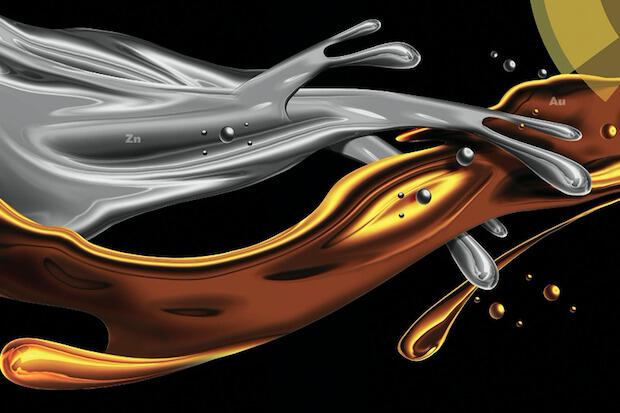
Aug. 15, 2017
Gold compounds could lead to new approaches in HIV drug development
Share this story
Virginia Commonwealth University researchers have discovered that gold compounds can be effective at reducing the infectivity of HIV in laboratory experiments.
The experiments have shown gold compounds may inhibit HIV by binding to an essential zinc-based protein and changing the shape of the protein, which prevents its attachment to DNA and RNA. The zinc-based proteins occur widely in nature and have roles in the progression of many diseases.

"This finding could eventually lead to HIV-fighting therapeutics and open up a new direction in the field of medicinal inorganic chemistry,” said Nicholas Farrell, Ph.D., principal investigator on the experiments and a professor in the Department of Chemistry in the College of Humanities and Sciences.
Previous studies from other researchers have shown some anti-HIV activity for gold compounds, which have a long history in medicine and also have been used to specifically to treat rheumatoid arthritis. But Farrell’s work elucidating the mechanisms of gold compound and zinc protein interactions suggests new pathways for this action. His research was funded by the National Science Foundation.
Gold fingers
Before the zinc protein was exposed to the gold compound, zinc was bound in looped, finger-like structures to sulfur and nitrogen atoms in the protein’s cysteine — an amino acid that contains sulfur. The gold compound, which also takes on the finger-like quality of zinc, binds to cysteines because it has a high affinity for sulfur. The protein then changes from a tetrahedral shape (a pyramidal form) to a linear form. As a result, the protein is no longer able to bind to DNA and RNA, which impedes viral infectivity, Farrell said.
The researchers also used the diagnostic technique of mass spectrometry to identify the exact way gold replaces zinc in the protein. Mass spectrometry identifies and quantifies a specified molecule based on the molecule’s composition. A novel use of ion mobility mass spectrometry allowed the VCU researchers to separate the possible types of protein formed after interaction with the gold compound and to examine protein structure.
Top honors
Farrell’s findings were detailed in two papers — one featured in Chemical Communications at the beginning of 2017 and one featured in Angewandte Chemie this spring. The paper published in Angewandte Chemie was named a “Hot Paper,” which means it was chosen by editors for its importance in a rapidly evolving field of high interest.
Co-investigators on the initial paper include: Sarah R. Spell, Ph.D., and Erica J. Peterson, lab manager in the VCU Department of Chemistry; John B. Mangrum, Ph.D., and Daniele Fabris, Ph.D., in the Department of Chemistry at the University at Albany; and Roger Ptak, Ph.D., senior program leader of In Vitro Antiviral Drug Development at the Southern Research Institute.
Farrell was joined on the second publication by postdoctoral fellow Zhifeng Du, Ph.D., visiting graduate student Raphael E.F. De Paiva, Ph.D., in the Department of Chemistry and Kristina Nelson, Ph.D, director of the Proteomic Mass Spectrometry Core Facility and research assistant.
Subscribe for free to the VCU News email newsletter at http://newsletter.news.vcu.edu/ and receive a selection of stories, videos, photos, news clips and event listings in your inbox every Monday and Thursday during the academic year and every Thursday during the summer.
Subscribe to VCU News
Subscribe to VCU News at newsletter.vcu.edu and receive a selection of stories, videos, photos, news clips and event listings in your inbox.




